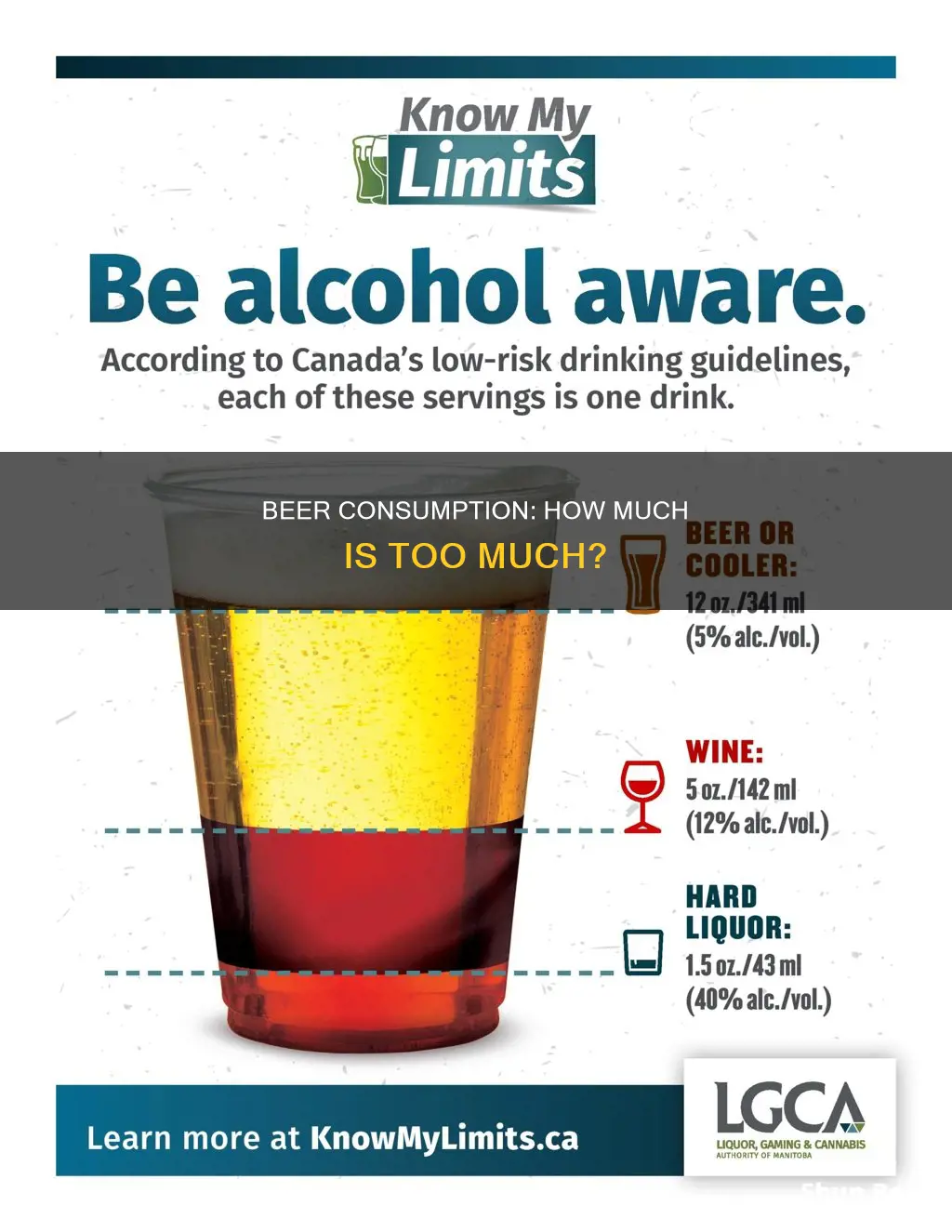
Drinking alcohol is a common social activity, but how much is too much? It's important to understand the impact of alcohol on your health and well-being. Excessive alcohol consumption can lead to negative consequences, including health issues, social problems, and even a shortened lifespan. So, how much beer is normal to drink? This depends on various factors and can vary from person to person. Let's explore this topic further and provide some guidelines to help you make informed decisions about your alcohol intake.
How Much Beer is Normal to Drink?
| Characteristics | Values |
|---|---|
| Number of Beers | 1-2 beers per day |
| Frequency | Occasional or moderate drinking |
| Binge Drinking | 4 or more beers for women, 5 or more for men in 2 hours |
| Heavy Drinking | 8 or more beers per week for women, 15 or more per week for men |
| Weekly Upper Limit | 3 beers in one day or 7 per week for women; 4 beers in one day or 14 per week for men |
| Standard Drink | 12 fl oz of beer, 5% alcohol content |
What You'll Learn

What is a standard drink?
In the United States, a "standard drink" or "alcoholic drink equivalent" is any drink containing 0.6 fluid ounces (14 grams) of "pure" ethanol. This is usually the amount of alcohol found in 12 ounces of regular beer (5% alcohol by volume), 5 ounces of table wine (12% alcohol by volume), or 1.5 ounces of 80-proof distilled spirits (40% alcohol by volume).
The amount of liquid in a glass, can, or bottle does not necessarily reflect the amount of alcohol it contains. Different types of beer, wine, or malt liquor can have varying alcohol content. For example, light beers typically have about 4.2% alcohol content, compared to 5% in regular beer. Microbrews, for instance, have more than 5% alcohol, so drinking a 10% alcohol beer means consuming two "standard" drinks.
The standard drink definition is helpful for following health guidelines, but it may not reflect customary serving sizes. For instance, cocktails often contain more than one standard drink's worth of alcohol, and the alcohol content and serving sizes can vary within and across beverage types.
Methodists and Beer: Is It Allowed?
You may want to see also

How much alcohol is too much?
It's important to note that alcohol is a drug, and there is no guaranteed safe amount of alcohol for anyone. However, general guidelines can help people understand how much alcohol is too much and minimize health risks. According to the National Institute on Alcohol Abuse and Alcoholism (NIAAA), to reduce risks, women should limit their intake to one drink or less per day, and men should limit themselves to two drinks or less per day. These guidelines are not averages but daily limits.
Exceeding these limits is considered "heavy" or "at-risk" drinking, which increases the likelihood of developing health problems. About one in four people who drink more than the recommended amount have an alcohol use disorder (AUD). Heavy drinking is defined as consuming eight or more drinks per week for women and 15 or more drinks per week for men. Binge drinking, a pattern of drinking that quickly raises blood alcohol concentration (BAC) to 0.08 g/dl or above, is also a form of excessive drinking. For men, this typically occurs after five or more drinks within two hours, and for women, it's four or more drinks in the same time frame.
The amount of alcohol considered excessive can vary depending on factors such as gender, mood, food intake, speed of consumption, tolerance, physical condition, medication, carbonation, and altitude. Alcohol affects men and women differently due to differences in estrogen levels, body fat, body water levels, and enzymes that break down alcohol. It's important to note that even if two people consume the same total amount of alcohol in a week, their health consequences could differ. For example, drinking seven drinks in one night and abstaining for the rest of the week is not the same as having one drink every night for a week. Regularly drinking heavily and frequently is considered "risky."
The negative health consequences of excessive drinking are extensive and include unintentional injuries, violence, risky sexual behaviors, memory and learning problems, early dementia, inflammation, organ damage, chronic diseases (such as liver disease, heart disease, stroke, high blood pressure, and cancer), ulcers, gastrointestinal issues, malnourishment, weakened immune system, higher risk of obesity, and mental health issues like depression and anxiety. Excessive drinking can also lead to social and professional problems, including decreased productivity, job loss, financial issues, and relationship difficulties.
While moderate drinking may offer some health benefits, such as a reduced risk of heart disease, neurodegenerative diseases, and type 2 diabetes, these benefits can be outweighed by the negative consequences of heavy drinking. Therefore, it's crucial to drink responsibly and not exceed the recommended limits.
Brushing Teeth After Beer: Necessary or Not?
You may want to see also

What are the health consequences of drinking excessively?
Excessive alcohol consumption can have a serious impact on your health. The health consequences of drinking excessively are wide-ranging and can affect nearly every part of the body. Here are some of the key health issues that can arise from drinking excessively:
Liver Damage
Excessive drinking can lead to liver disease, including alcoholic fatty liver disease, steatosis, and cirrhosis. Alcohol is a toxin that the liver has to filter out. Heavy drinking can cause liver cells to die and lead to scarring and inflammation.
Cardiovascular Problems
Drinking excessively can increase your risk of heart-related issues, including cardiomyopathy, arrhythmias, and high blood pressure. Studies have also shown that heavy drinkers are more likely to have trouble pumping blood to the heart and may have a higher chance of dying from heart disease.
Pancreatic Issues
Alcohol causes the pancreas to produce toxic substances that can lead to pancreatitis, a dangerous inflammation that causes swelling and pain and impairs the pancreas's ability to produce enzymes and hormones for proper digestion.
Cancer
There is a clear link between heavy alcohol use and an increased risk of several types of cancer, including mouth, throat, breast, liver, and intestinal cancers. Even moderate drinking can increase the risk of certain cancers.
Immune System Weakening
Chronic heavy drinking can weaken your immune system, making you more susceptible to diseases such as pneumonia and tuberculosis. Drinking excessively can also increase your risk of contracting infections up to 24 hours after getting drunk.
Brain and Nervous System Damage
Alcohol interferes with the brain's communication pathways, affecting mood, behaviour, clear thinking, and coordination. Heavy drinking can also lead to mental health issues like depression and dementia and increase the risk of epilepsy.
Gastrointestinal Issues
Excessive drinking can cause inflammation and ulcers in the stomach, oesophagus, and intestines, leading to chronic conditions such as heartburn, nausea, and malnutrition. It can also affect the body's ability to absorb important nutrients.
Sleep Disturbances
While alcohol may help you fall asleep initially, it can disrupt your sleep later in the night, leading to reduced sleep quality. Binge drinking can also increase snoring and sleep apnea, making it difficult to get a good night's rest.
Other Health Risks
Excessive drinking is also associated with a higher risk of obesity, vitamin deficiencies, unintentional injuries, violence, risky sexual behaviours, memory and learning problems, and a range of other short-term and long-term health issues.
Beer and Zoloft: Is It Safe to Drink Alcohol?
You may want to see also

What are the benefits of drinking beer?
Drinking beer in moderation may have some health benefits. However, excessive consumption can lead to many serious health issues. It is important to note that the benefits of drinking beer are only relevant when consumed in light or moderate amounts.
Benefits of drinking beer
Lower risk of heart disease
Beer may help decrease the risk of heart disease by increasing high-density lipoprotein (HDL), also known as "good cholesterol". Beer also contains vitamin B6, which can help lower homocysteine levels, a chemical considered a risk factor for heart disease.
Decreased risk of Alzheimer's and dementia
Moderate consumption of beer may help decrease the risk of neurodegenerative diseases such as Alzheimer's disease.
Lower risk of osteoporosis
Some research suggests that moderate alcohol consumption may help decrease the risk of osteoporosis, a disease that causes bones to become brittle and more susceptible to breaks.
Lower risk of type 2 diabetes
People who drink alcohol in moderate amounts seem to have a lower risk of developing type 2 diabetes.
Preventing ulcers
Moderate to high consumption of beer may help reduce the risk of Helicobacter pylori (H. pylori) infection, a bacterium that causes ulcers.
Nutritional value
Although beer is not a suitable alternative to a nutritious, balanced diet, it does contain various nutrients, including minerals such as selenium, magnesium, phosphorus, and vitamins such as vitamin B1, B2, B3, B5, and B12.
According to the National Institute on Alcohol Abuse and Alcoholism, drinking levels can be broken down into three categories: low-risk drinking, binge drinking, and heavy drinking. Low-risk drinking is defined as up to one drink per day for women and up to two drinks per day for men. Binge drinking is defined as consuming four or more drinks for women and five or more drinks for men within about two hours. Heavy drinking is defined as eight or more drinks per week for women and 15 or more drinks per week for men.
Underage Beer Drinking: What's the Deal?
You may want to see also

How to cut back on drinking beer?
Drinking beer in moderation is generally considered normal. However, excessive drinking can lead to several health issues and negative consequences. Here are some tips to help you cut back on drinking beer:
Set realistic goals and stick to them
Decide on a realistic target for reducing your beer consumption and work towards it. Be proud of yourself when you achieve your goal and set a new one if needed.
Increase alcohol-free days
Instead of focusing on the number of beers you drink per day, try increasing the number of days per week when you don't drink any beer. This will instantly reduce your overall consumption and make you feel better.
Track your drinking
Keep a drinking diary to record when, what, and why you drink. This will help you identify patterns and triggers for your beer drinking. Once you are aware of these, you can think of alternative ways to fulfil the purpose served by beer.
Socialise without beer
If your social activities revolve around drinking beer, try arranging to meet your friends for a coffee, a walk, or another activity that doesn't involve alcohol.
Have a get-out plan
If you find yourself in a situation where beer is available and you're tempted to drink, have a plan to help you avoid drinking. For example, you could pre-book a taxi home or only bring enough money to buy a set number of beers.
Experiment with relaxation techniques
If you find that you drink beer to relieve stress or anxiety, try alternative methods such as meditation, breathing exercises, or listening to calming music. These can help you manage cravings and reduce your beer intake.
Keep yourself busy
Take up a new hobby or activity to distract yourself from thoughts of drinking beer. This can help remove the temptation to drink and provide you with a sense of accomplishment.
Swap beer for non-alcoholic drinks
When you feel like drinking beer, opt for a non-alcoholic version or a different non-alcoholic drink. This allows you to still enjoy the taste and social aspects of drinking without consuming alcohol.
Keep your home alcohol-free
Remove the temptation to drink beer by not keeping any at home. Also, let your friends and family know that you're cutting down so they can support you and not pressure you to drink.
Enjoy the benefits of reduced beer consumption
Reducing your beer intake can bring several immediate and long-term benefits, such as improved sleep, increased energy, better weight management, and reduced health risks. Remind yourself of these benefits to stay motivated.
Seek support if needed
If you feel that you need help to cut back on drinking beer, don't be afraid to reach out. Speak to a trusted friend or family member, or seek professional support from a therapist or counsellor.
Beer on the Sausalito Ferry: What You Need to Know
You may want to see also
Frequently asked questions
There is no universally accepted definition of "normal" when it comes to alcohol consumption. However, according to the National Institute on Alcohol Abuse and Alcoholism, the US Dietary Guidelines recommend that women have no more than 1 drink per day and men have no more than 2 drinks per day. These guidelines are not averages but rather daily limits.
Excessive drinking is generally categorised into two types: binge drinking and heavy drinking. Binge drinking is defined by the CDC as consuming enough alcohol to reach a blood alcohol concentration (BAC) of 0.08 g/dl or higher. This typically occurs when men consume 5 or more drinks and women consume 4 or more drinks within a 2-hour period. Heavy drinking is defined as consuming 8 or more drinks per week for women and 15 or more drinks per week for men.
Excessive beer drinking can have numerous negative consequences on both physical and mental health. It can increase the risk of unintentional injuries, violence, risky sexual behaviours, memory and learning problems, early dementia, tissue and organ damage, chronic diseases (such as liver disease, heart disease, stroke, high blood pressure, and cancer), gastrointestinal issues, malnourishment, weakened immune system, obesity, depression, and anxiety. Additionally, excessive drinking can lead to problems in personal and professional life, including decreased productivity, job loss, financial issues, and relationship difficulties.







